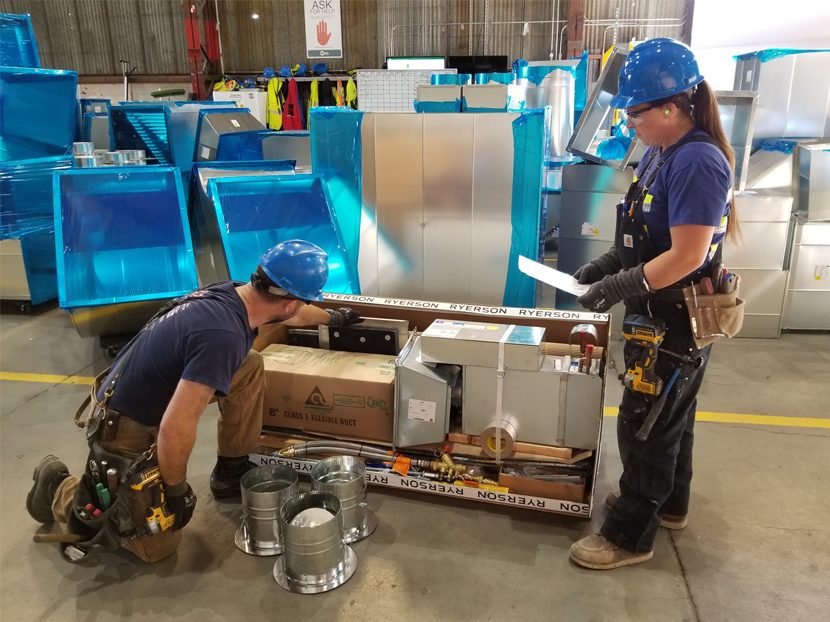Jobsite Efficiency Starts with Supply Chain Optimization
Technology and process innovations such as kitting are changing construction jobsites.

Construction superintendents and foremen carry tremendous responsibility in ensuring work quality, project schedules and budgets. That responsibility involves day-to-day workflow as well as looking into the future to stay three steps ahead of work crews.
Evaluating supervisors’ day-to-day work, however, tells a much different story. It quickly becomes clear how much of their workday is spent fighting small emergencies to keep everyone on the jobsite working efficiently. That’s not because skilled tradespeople aren’t working hard, but because of the sheer number of inefficiencies in the traditional supply chain.
McKinstry CEO Dean Allen often shares stories of what it was like as a plumber years ago. Plumbers would arrive at the jobsite and start each day by mapping parts and systems against what needs to be done. In an ideal world, everything would already be on site and flagged for fabrication and installation.
More likely, individual parts would be missing or wrong, leaving the superintendent or foreman to find a replacement while the plumber made do with what was available. It typically involved borrowing from other areas on the jobsite (leaving them without parts down the road), looking through each truck for spares or heading back to the supply house to order and pick up the missing parts.
A lot has changed in the past 40 years. We now have robust inventory and order management platforms to streamline the process. Those platforms are even being integrated into design and fabrication software to dynamically update what’s needed (and available) with every change order. RFID and barcodes track major parts, with deliveries scheduled and tracked through fleet telematics.
Despite that, Dean’s example still rings true on most jobsites. Technology creates possibilities, but processes also need to be developed to make the most of those possibilities. It’s why superintendents spend as much as 85 percent of their days on unexpected emergencies, leaving as little as one hour per day for planning.
Don’t believe me? Ask your superintendent how much time is wasted chasing supplies. The problem is systemic with real consequences. However, the opportunity to drive efficiency and cut waste is high.
A better approach
Each step in today’s supply chain introduces a value-add opportunity. As I discussed in my December column, fabrication shops offer an ideal testbed for automation. These automation technologies are an early step, but the opportunity is much larger.
Take, for example, kitting, which is commonplace in manufacturing and other industries because it significantly improves productivity and reduces costs. The best example comes from my favorite Swedish furniture provider. If I were to remodel my home office, I would measure, design and specify the required equipment — desk, chair, filing cabinets, task lighting, bookshelves and varying accessories. The Swedish furniture store has everything I need, pre-packaged in flat boxes ready for delivery and assembly. All I need to do is open the box and put everything together.
The same process is possible in the construction industry. Kitting can help streamline the overall flow of materials, tools and information to tradespeople on jobsites, maximizing efficiency and allowing them to do what they do best. This requires coordination and highly organized planning across engineering, detailing, field leaders, purchasing, fabrication shop and other logistics assets. But the benefits are worth the effort.
Imagine a process where parts and systems are ordered from the latest design specifications and delivered to the fabrication shop. From there, tradespeople measure and cut everything to spec, pre-assembling and labeling as much as possible. All components, fittings and hardware are packaged onto a pallet and delivered to the jobsite. Tradespeople receive the pallet, knowing they have everything needed to assemble and install the system without delays.
Kitting maximizes the time highly skilled tradespeople spend at the point of install. It also allows employees to focus on their core competencies, providing short-term gains by eliminating nonvalue-added activities. More importantly, it allows superintendents to spend 85 percent of their day planning ahead instead of troubleshooting unplanned emergencies tied to the supply chain.
Supply chain of the future
Technology continues to push what’s possible in construction supply chain management. Kitting demonstrates how technology blends with process to drive efficiency and cut waste. It’s an important example as more and more technologies are introduced in our industry. These technologies will expand upon the kitting concept, driving efficiency further and cutting even more waste.
Sensors and telematics can extend inventory management to ensure each jobsite has the tools needed when and where needed. Very shortly, superintendents will be able to pull up a map of the jobsite and see every tool on site, where it’s located and what specific job tasks it’s assigned to perform.
Imagine the timesavings of not having to run up and down the project site trying to find equipment that’s been misplaced or borrowed without notification. Instead, the system will run ongoing inventory scans and inform you if tools are missing, in the wrong place or have not arrived in time for a needed task. That functionality could then be extended to ensure jobsite equipment is working properly and onsite workers are trained and certified to use the equipment.
Looking forward, integrated software platforms will soon align project change orders to the supply chain. Superintendents will receive more than change order notifications. Instead, the supply chain management system will automatically recalibrate itself to ensure the jobsite receives the needed parts, tools and manpower on time — eliminating unplanned complications and delays.
McKinstry is making headway in this area with our OMega platform, which connects design specifications and inventory order management processes between our engineering groups and fabrication shop.
Technology and process innovations are changing construction jobsites quickly. It’s exciting to see these innovations adopted and to imagine what that adoption could lead to next. I hope we continue to expand supply chain optimization as a much-needed opportunity to drive efficiency.





